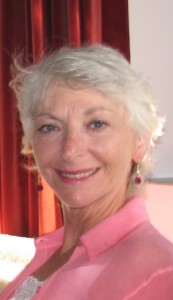15th October 2014 (+ AGM at 10.30am) (3rd Wed) The Collections of Isaac and Moïshe de Camondo.
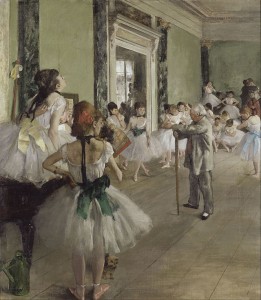 Late 19th century Paris. Two cousins from a wealthy Jewish banking family: Isaac, a writer of music, who haunted the Paris Opera Garnier pursuing the singers and ballet dancers, was also a collector of Japanese art and Impressionist and Post-Impressionist paintings. He bequeathed his collection to the Louvre in 1911. His cousin Moïshe was passionate about racing fast cars and 18th century French Decorative Art. He made a significant gift to the French state of his house in Paris and one of the most important collections of 18th century French Decorative Art anywhere.
Late 19th century Paris. Two cousins from a wealthy Jewish banking family: Isaac, a writer of music, who haunted the Paris Opera Garnier pursuing the singers and ballet dancers, was also a collector of Japanese art and Impressionist and Post-Impressionist paintings. He bequeathed his collection to the Louvre in 1911. His cousin Moïshe was passionate about racing fast cars and 18th century French Decorative Art. He made a significant gift to the French state of his house in Paris and one of the most important collections of 18th century French Decorative Art anywhere.
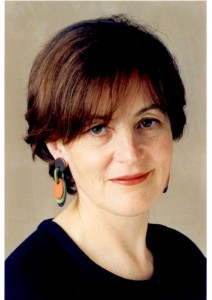 Lecturer: Deborah Lambert is curator of the Schroder Collection, a private art collection. She studied for her MA in History of Art at the Courtauld Institute and, until taking up her present post, worked for many years as an academic director and lecturer for Christie’s Education. She appears regularly as a furniture specialist on the Antiques Roadshow.
Lecturer: Deborah Lambert is curator of the Schroder Collection, a private art collection. She studied for her MA in History of Art at the Courtauld Institute and, until taking up her present post, worked for many years as an academic director and lecturer for Christie’s Education. She appears regularly as a furniture specialist on the Antiques Roadshow.
12th November 2014 (2nd Wed) The Art of the Black Death.
In 1348 much of western Europe was devastated by bubonic plague, outbreaks of which continued to occur until the end of the 15th century. The art produced in Italy during this period offers a vivid insight into the traumatic impact of these terrible events on people’s psyche, the plague being seen as a punishment from God. There was a great boom in the cults of saints who, it was believed, could provide protection against the Black Death; talismanic images of them were painted everywhere. In this lecture you will find out how and why the mysterious mediaeval pilgrim St. Roch and the early Christian martyr St. Sebastian emerged as the most popular plague saints.
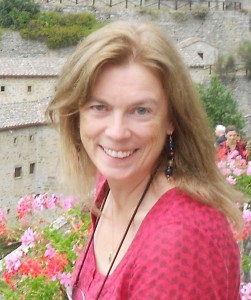 Lecturer: Janet Robson An independent art historian, with a BA in History from UCL, an MA in Early Sienese Painting and a PhD in History of Art from the Courtauld Institute, Janet Robson has over a decade of lecturing and teaching experience for institutes such as the Courtauld, Birkbeck and Christie’s Education as well as for private study groups. She has published extensively on thirteenth and fourteenth century Italian art. Her latest publication, The Making of Assisi: the Pope, the Franciscans and the Painting of the Basilica (co-written with Donal Cooper) was published in August 2013 by Yale University Press.
Lecturer: Janet Robson An independent art historian, with a BA in History from UCL, an MA in Early Sienese Painting and a PhD in History of Art from the Courtauld Institute, Janet Robson has over a decade of lecturing and teaching experience for institutes such as the Courtauld, Birkbeck and Christie’s Education as well as for private study groups. She has published extensively on thirteenth and fourteenth century Italian art. Her latest publication, The Making of Assisi: the Pope, the Franciscans and the Painting of the Basilica (co-written with Donal Cooper) was published in August 2013 by Yale University Press.
17th December 2014 (3rd Wed) John Betjeman: First and Last Loves of Architecture.
In the lecturer’s words, Betjeman ‘inspired and showed a public not only what to look at with love, but what to love and look after for the future’. A poet, writer and broadcaster, in 1972 Betjeman became the UK’s Poet Laureate. His first and last loves were architecture, particularly churches and railway stations, the foibles and frailties of human nature, landscape and the spirit of place. He was a pioneer in creating an awareness of the need for the conservation and preservation of good architecture. He sharpened perceptions and heightened a sense of aesthetic appreciation.
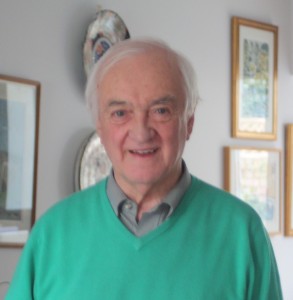 Lecturer: Denis Moriarty An Oxford history graduate, Denis spent 30 years at the BBC where he directed and produced documentaries on art, architecture, cultural history and music. His programmes included the series on English Towns and Face the Music. His prime interests are music and architecture: he sang for some years in the Philharmonic Chorus and wrote Buildings of the Cotswolds. Currently he lectures for NADFAS and directs study courses at music festivals at home and abroad. He also leads architectural and historical tours for private parties to destinations as diverse as America and India.
Lecturer: Denis Moriarty An Oxford history graduate, Denis spent 30 years at the BBC where he directed and produced documentaries on art, architecture, cultural history and music. His programmes included the series on English Towns and Face the Music. His prime interests are music and architecture: he sang for some years in the Philharmonic Chorus and wrote Buildings of the Cotswolds. Currently he lectures for NADFAS and directs study courses at music festivals at home and abroad. He also leads architectural and historical tours for private parties to destinations as diverse as America and India.
14th January 2015 (2nd Wed) Satirist to Insanity: celebrating the life and works of James Gillray (1756 – 1815).
James Gillray was the natural successor to William Hogarth but represented, in his cutting and cruel caricatures, everything about satirical prints that Hogarth despised. Uncompromising and fearless in his art, Gillray tore into politicians and the royal family alike. Yet, full of contradictions, that didn’t stop him pursuing a staunchly patriotic stance when it came to the French Revolution, nor accepting a pension to tone down his satirical bite. He died, insane, in 1815 and his reputation in the Victorian climate of moralistic righteousness plummeted. It is only now that he can be seen as the natural forefather of Spitting Image and the cartoons of Gerald Scarfe and Steve Bell although none of these have quite matched the wit and vitriol of Gillray at his best.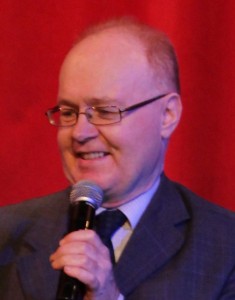 Lecturer: Ian Keable gained a first class degree from Oxford in PPE, qualified as an accountant, then became a professional magician. A member of the Inner Magic Circle with Gold Star, he has written and presented a Radio 4 documentary on mind readers and is currently performing in The Secret World of Charles Dickens, a show about the famous Victorian novelist who was also an amateur conjuror. A collector of 18th and 19th century books, posters and prints relating to magic and hoaxes, Ian has lectured from London to Los Angeles.
Lecturer: Ian Keable gained a first class degree from Oxford in PPE, qualified as an accountant, then became a professional magician. A member of the Inner Magic Circle with Gold Star, he has written and presented a Radio 4 documentary on mind readers and is currently performing in The Secret World of Charles Dickens, a show about the famous Victorian novelist who was also an amateur conjuror. A collector of 18th and 19th century books, posters and prints relating to magic and hoaxes, Ian has lectured from London to Los Angeles.
11th February 2015 (2nd Wed) The Shakers: their Beliefs, Architecture and Artefacts.
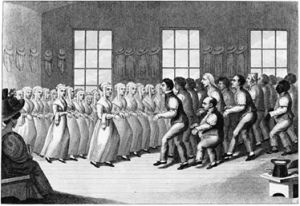 The Shaking Quakers had their origins in 18th century England but are much better known as a successful 19th century North American fundamentalist sect. In this lecture we are told the extraordinary story of the Shakers, exploring their beginnings, what they believed and how they lived their lives, before examining examples of their wonderful buildings and furniture, for it is only with such an understanding of their devout faith and way of life that we can begin to appreciate the beauty of their intriguing legacy.
The Shaking Quakers had their origins in 18th century England but are much better known as a successful 19th century North American fundamentalist sect. In this lecture we are told the extraordinary story of the Shakers, exploring their beginnings, what they believed and how they lived their lives, before examining examples of their wonderful buildings and furniture, for it is only with such an understanding of their devout faith and way of life that we can begin to appreciate the beauty of their intriguing legacy.
 Lecturer: John Ericson. Formerly a lecturer at the University of Bath and Director of Studies in the School of Education, Ian has also worked extensively overseas as an educational consultant. This has given him the opportunity to give lectures and presentations to conferences all over the world. As well as the talks he has developed from his professional background, he offers presentations on an eclectic range of topics from antique corkscrews to Norman Rockwell; these derive from his diverse interests and enthusiasms.
Lecturer: John Ericson. Formerly a lecturer at the University of Bath and Director of Studies in the School of Education, Ian has also worked extensively overseas as an educational consultant. This has given him the opportunity to give lectures and presentations to conferences all over the world. As well as the talks he has developed from his professional background, he offers presentations on an eclectic range of topics from antique corkscrews to Norman Rockwell; these derive from his diverse interests and enthusiasms.
11th March 2015 (2nd Wed) Symphonies in Colour: The Mosaics of Ravenna.
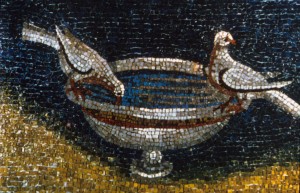 Ravenna with its cluster of 5th and 6th century churches, baptisteries and mausoleums contains some of the finest examples of Christian art, a kaleidoscopic array of glittering wall mosaics. This was an art form in which the Byzantines excelled, producing examples of truly outstanding beauty and technical perfection in Ravenna. Dante describes the mosaics as “ A great symphony of colour, their chief characteristics being clarity, harmony, brilliant colours and decorative rhythmic design”.
Ravenna with its cluster of 5th and 6th century churches, baptisteries and mausoleums contains some of the finest examples of Christian art, a kaleidoscopic array of glittering wall mosaics. This was an art form in which the Byzantines excelled, producing examples of truly outstanding beauty and technical perfection in Ravenna. Dante describes the mosaics as “ A great symphony of colour, their chief characteristics being clarity, harmony, brilliant colours and decorative rhythmic design”.
Lecturer: Jane Angelini has a BA in Russian Studies and an MA in Byzantine and Early Russian Art and Architecture. She runs her own Art Tours company and is a freelance lecturer for NADFAS and other arts organizations. She speaks several foreign languages and has translated a number of works of 19th century Russian literature for Penguin Books and OUP.
8th April 2015 (2nd Wed) KIcking and Screaming: A Brief Story of Post-War British Art.
This lecture explains what has been going on in British art since 1945 when Francis Bacon caused ‘total consternation’ with his raw and visceral canvasses. His work was part of a wider phenomenon called the ‘geometry of Fear’ by a leading critic of the day. From that point, the talk tracks key moments in British art decade by decade, through the curious mixture of modernism and pastoralism which is associated with the Festival of Britain; the Pop Art and Conceptualism of the 1960s and 70s; the 1980s and 90s which gave us the Turner Prize and Sensation exhibition, and on to the present day. However,despite all these highly public shocks, figurative painters like Francis Bacon and Lucien Freud were quietly getting on with it in the background and one of the great stories of post-war British art is the continuing strength and vigour of that tradition.
Lecturer: Linda Smith is a highly qualified Art Historian with particular knowledge and interest in British Art and the art of the twentieth century. In her MA at Birkbeck she specialised in Post-Modernism. An experienced guide and lecturer at Tate Britain, Tate Modern and the Dulwich Picture Gallery, she lectures to secondary school audiences and independent arts societies.
20th May 2015 (3rd Wed) Pearls and Pomegranates, Peacocks and Pipes: the hidden language of Renaissance Art.
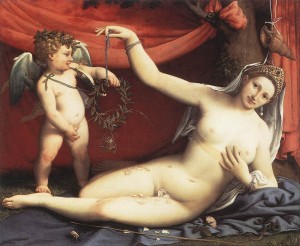
Venus and Cupid – Lorenzo Lotto c. 1540, Oil on canvas, 92 x 111 cm
Metropolitan Museum of Art, New York, www.metmuseum.org
It is sometimes difficult for us to understand the full meaning of painting from the past due to the wealth of symbolism it contains, much of it obscure to us but instantly recognizable to its contemporaries. This lecture aims to peel back the layers of Renaissance art by deciphering the meaning of some of these symbols – spiritual and secular, virginal and vulgar – and so enable us to read these paintings as did the people for whom they were intended.
Lecturer: Shirley Smith graduated from the University of East Anglia with first class honours in History of Art. Fellow of the Royal Society of Arts and part-time lecturer for the University of East Anglia and for the Department of Continuing Education of the University of Cambridge, she also lectures for the Art Fund and individual clubs and societies. She is particularly keen to set the art and architecture of a period in the context of the society for which it was produced.
10th June 2015 (2nd Wed) Frederick the Great: Soldier and Collector.
Frederick was a truly remarkable man with enormous talent. An intellectual, a fine musician and composer, a collector and builder of exquisite taste, a friend of Voltaire, one of the greatest soldier of his time, venerated by both Napoleon and Wellington, he was loved by all who knew him.
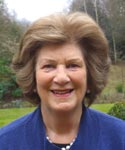 Lecturer: Caroline Rayman has lectured for many years to universities and art organisations in America and on cruise boats. She was an official guide at the British Museum and has published articles on samplers. Her lectures range from the role of royal mistress in history to more scholarly lectures such as this one on Frederick the Great of Prussia.
Lecturer: Caroline Rayman has lectured for many years to universities and art organisations in America and on cruise boats. She was an official guide at the British Museum and has published articles on samplers. Her lectures range from the role of royal mistress in history to more scholarly lectures such as this one on Frederick the Great of Prussia.

![Gillray - Plumb Pudding Library of Congress, Prints & Photographs Division, [reproduction number, LC-USZC4-8791]](http://theartssocietyoxford.org.uk/wp-content/uploads/2014/07/gillray_plumb-pudding-300x217.jpg)

